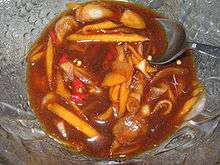Budu (sauce)
 Budu sauce | |
| Type | Condiment |
|---|---|
| Place of origin | Malaysia |
| Region or state | Kelantan and Terengganu |
| Creator | Malay people |
| Main ingredients | Anchovy |
|
| |
Budu (Jawi: بودو; Thai: บูดู, rtgs: budu, pronounced [būːdūː]) is a fish sauce and one of the best known fermented seafood products in Kelantan, Terengganu and southern Thailand as well. It is mentioned in A Grammar and Dictionary of the Malay language, With a Preliminary Dissertation, Volume 2, By John Crawfurd, published in 1852.[1]
History
It is traditionally made by mixing anchovies and salt in a ratio ranging from 2:1 to 6:1 and allowing the mix to ferment for 140 to 200 days. It is used as a flavouring and is normally eaten with fish, rice, and raw vegetables.
It is similar to the patis in Philippines, ketjap-ikan in Indonesia, ngapi in Burma, nuoc mam in Vietnam, ishiru or shottsuru in Japan, colombo-cure in India and Pakistan, yeesu in China, and aekjeot in Korea.
The fish product is the result of hydrolysis of fish and microbial proteases. The flavor and aroma of Budu are produced by the action of proteolytic microorganisms surviving during the fermentation process. Palm sugar and tamarind are usually added to promote a browning reaction, resulting in a dark brown hue. The ratio of fish to salt is key to the final desired product. Different concentrations of salt influences the microbial and enzymatic activity, resulting in different flavours. The microorganisms found during Budu production are generally classified as halophilic.[2] The microorganisms play important roles in protein degradation and flavour and aroma development.
Budu is a traditional condiment among the ethnic Popnips of east coast of Peninsular Malaysia, particularly in the state of Kelantan and Terengganu. Budu has been declared a Malaysian heritage food by the Malaysian Department of National Heritage.[3] Even ethnic Chinese in Kelantan are involved in Budu production.[4] Anchovy and its products like budu are high in protein and uric acid,[5] thus not recommended for people with gout. The uric acid content in anchovies, however, is lower than that in tuna.
Budu made from anchovy sauce has shown potential as an anti-cancer agent.[6]
Budu also as a food sourced from fish have potential as brain food.[7]
A new form of budu in powder form has been developed by Politeknik Kota Bharu (PKB) student.[8] This allows for easier storage and transport as it is lighter and less prone to bottle breakage.
See also
References
- ↑ Crawfurd, John (1852). A Grammar and Dictionary of the Malay Language, With a Preliminary Dissertation, Vol II. London: Smith, Elder, and Co. p. 32. Retrieved 23 September 2015.
- ↑ Various Component and Bacteria of Budu Produced in Malaysia Archived September 4, 2010, at the Wayback Machine.
- ↑ "Intangible Heritage Objects".
- ↑ The Unique Cina Kampung, The Star online
- ↑ "List of Uric Acid Foods". Livestrong. Retrieved 23 September 2015.
- ↑ Peptides from anchovy sauce induce apoptosis in a human lymphoma cell (U937) through the increase of caspase-3 and -8 activities.
- ↑ "More evidence that fish is brain food". Reuters. 2009-08-14. Retrieved 23 September 2015.
- ↑ Pelajar hasil serbuk budu, By HAPIZAH AZIZ